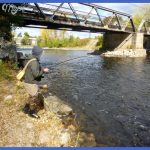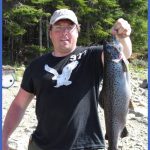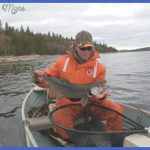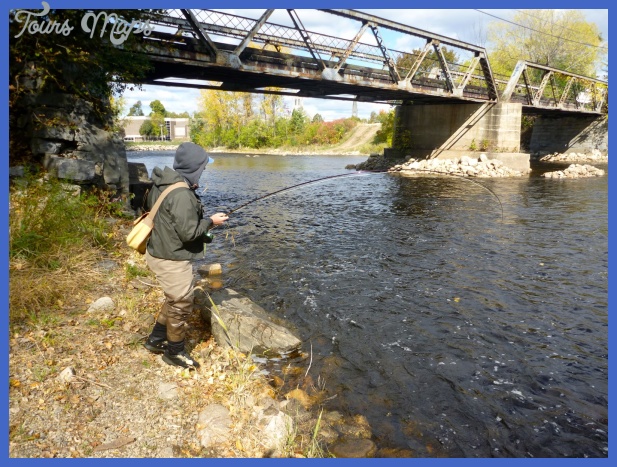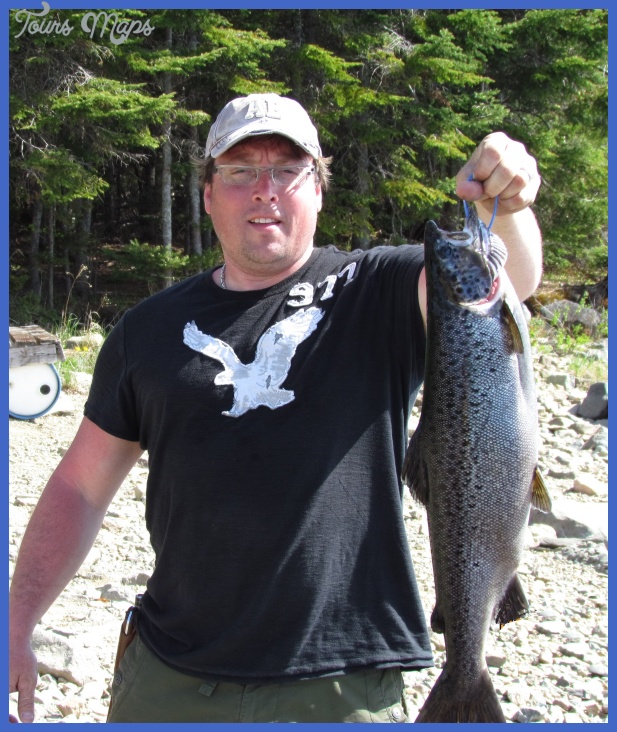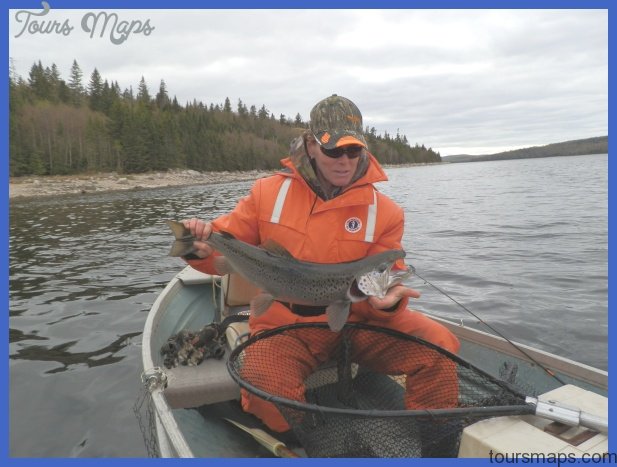Landlocked salmon, Salmo salar sebago, are Maine’s glamour fish. These silvery battlers are known for their leaping ability, savage strikes, and swift, powerful runs. In Maine, landlocked salmon are found in both rivers and lakes.
Because of the fish’s popularity, the Maine Department of Inland Fisheries & Wildlife regularly stocks landlocked Salmon in Maine lakes and rivers. In 1995, the agency stocked 190,458 landlocked salmon in Maine.
Landlocked salmon need cold, pure water in order to thrive. Fortunately, Maine is well endowed with waters suitable for salmon. In fact, Maine has more landlocked salmon waters than any other state in the nation.
An abundance of smelt, a slim, toothy bait fish, is another reason for the state’s renowned landlocked salmon fishing. Smelt are a major forage species for landlocked salmon. In the early spring, just after ice-out, schools of smelt cruise shorelines as they prepare to ascend small streams and brooks to spawn.
At this time, anglers using smelt imitations can take salmon just beneath the surface. Dozens of artificial lures and flies have been designed for the sole purpose of imitating smelt. Commercial bait dealers trap live smelt and sell them as bait. Maine’s smelt are the basis for a productive industry.
Landlocked salmon taken immediately after ice-out often have a yellowish hue, the result of a winter spent under the ice, away from sunlight. After a few days in the open water and exposure to direct sunlight, the fish soon regain their normal silvery appearance.
The flesh of landlocked salmon is more delicately flavored than that of seagoing salmon. Even anglers who are dedicated to catch-and-release often save at least one landlocked salmon to cook on the grill with a little pepper and a squirt of lemon juice.
Most of the landlocked salmon you catch will weigh 2 pounds or less, but 4-pound specimens are not uncommon, and fish weighing 8 to 10 pounds are always possible. The Maine record landlocked salmon weighed 22.5 pounds and was taken from Sebago Lake in 1907. You are not likely to hook a fish of that size, but even a 5-pound landlocked salmon can provide the freshwater angling thrill of a lifetime.
Techniques
Trolling with streamer flies – A 9-foot fly rod is best for this specialized form of fishing, but
8-footers will suffice. You will have the best results with a fairly soft rod-action, since landlocked salmon strike fast and a too-stiff rod is liable to tear the hook out on a strike. Modern graphite rods are sensitive and forgiving, but some of the older glass models are too stiff.
You don’t need to worry about tapered leaders and fine tippets. Length of leader is the biggest concern. Level monofilament will do just fine. Use at least 15 feet of 6-pound test leader. If the fish are more than a few feet down, you may need up to 30 feet.
Most anglers use a sinking fly line, but a floating line will do if you add weight. Do make sure your line-to-leader connection is smooth and neat. If it isn’t, it may catch on your top guide and allow the fish to escape.
Make sure your fly reel is loaded with plenty of backing and has a smooth drag. One of Maine’s trophy landlocked salmon can tear a fly line off a reel faster than it takes to talk about it.
Trolling for landlocked salmon with streamer flies is best done during breezy or even windy days. Mainers refer to small whitecaps as ”salmon chop.” Some of Maine’s lakes can be dangerous during high winds, so listen to the weather forecast. If a lake’s boating advisory is in effect, don’t go on the water.
Up to three persons can troll for landlocked salmon at the same time and not be in each other’s way. A rod on either side plus one straight off the stern is a common setup.
When you begin trolling, start with most of your fly line out. If you don’t get any strikes, try using a shorter line. In fact, salmon are often attracted to the bubbles of the prop wash and can be taken within 10 feet of your boat.
Landlocked salmon are capable of swimming at high speeds, as are smelt, so troll at a good clip. Work the shorelines and coves and especially the mouths of streams and brooks. If you find where the smelt are schooling, you will have also found landlocks. Look for dead smelt floating on the surface.
Landlocks tend to slash at bait fish, crippling them first and eating them at their leisure. Use a hook sharpener to keep your hooks needle-sharp and you will get more hookups.
When the fishing is slow, anglers sometimes tire of holding their rods and place them in a rod holder. The value of these devices is debatable, since they require a fish to hook itself. You will hook more fish if you are holding the rod when the fish strikes. Still, when cold sleet makes holding a rod a chore, you may need to resort to a rod holder.
Streamer patterns for trolling – Selecting the proper streamer fly pattern for landlocked salmon is a guessing game. What makes fly selection even more interesting is the fact that what the landlocks are crazy for today may be ignored tomorrow.
Streamers come tied on either a single, long-shanked hook, or on a tandem setup, with two single hooks fastened together by plastic-coated wire. Both types of fly are useful and both are suited to a specific task.
Single-hook streamers are, by virtue of their design, smaller than tandem streamers. In a lake where the forage fish run small, a single-hook streamer will take more fish. This is in keeping with the notion that you will take more fish if you match your lure size to the size of the natural bait. The drawback to using these is that the single, long-shanked hook allows the fish to apply leverage and possibly tear the hook out.
Tandem-hook streamers are preferred by the majority of anglers. When you go to a lake for the first time, begin with tandems; if you don’t get a strike, switch to the smaller variety.
Streamers come in a wide variety of patterns, and new ones appear each year. Some anglers design their own patterns for specific waters. Still, you will not go wrong by sticking to tried-and-true patterns. Any of the following will take fish anywhere in Maine: gray ghost, black ghost, supervisor, Barnes special, pink lady, nine-three, Jerry’s smelt, queen bee, and red-and-white.
Like milk, butter, and eggs, streamer flies are a common item in most general stores in Maine. Additionally, any sporting-goods store will have a selection of streamers. When you buy streamers, stay away from bushy, over-dressed flies.
If any group of Maine landlocked salmon anglers were asked what they considered the best all-around streamer fly, they would surely choose the gray ghost. Whatever other patterns you decide to collect, make sure you have a few gray ghosts.
Fly casting – Landlocked salmon do not feed exclusively on smelt, to the delight of fly fishers. Often, a hatch of mayflies will bring landlocks to the surface. The author keeps a 9-foot fly rod strung up and ready to fish at all times, just in case landlocked salmon decide to go on a surface feed. Hooking a 3- or 4-pound landlocked salmon on a dry fly is an exciting, nerve-shattering experience, and one not soon forgotten. Fly casters sometimes take landlocked salmon in lakes, but Maine’s rivers offer more opportunities. Early-season anglers use single-hook streamers and weighted nymphs. As the season progresses and aquatic insects begin to hatch, dry-fly fishers experience the thrill of taking landlocked salmon with surface offerings.
Never use a fly rod lighter than 6-weight. A 9-foot rod is ideal, and 8-footers are acceptable. Some anglers, especially on the larger rivers, use an 8- or 9-weight, 10-foot rod.
When a hatch is on, you can get by with a 4-pound test tippet, but when the water is low, you may have to switch to 2-pound test. Leader length is not as critical as with brown trout, but in low, clear water, you will be better off using a 12-foot tapered leader.
Fly selections for fly casting – Many landlocked salmon rivers in the central and southern sections of the state are quite fertile and contain the usual assortment of mayflies. Northern freestone rivers are usually less fertile and contain a higher percentage of caddis flies than mayflies.
Generally speaking, landlocked salmon rivers tend to be big, with heavy flows. For that reason, you should carry an assortment of Wulff patterns, as well as a few irresistibles, in sizes 10 and 12. These bushy flies float well and are visible even in fast water.
The author has had across-the-board good luck on Maine’s landlocked salmon rivers with a single dry-fly pattern, the dun variant. This fly floats well when tied with the traditional quill body; in addition to imitating a specific mayfly, the dun variant is one of the best general patterns going. Carry a selection of dun variants in sizes 12 through 14.
Spin fishing – Spinning tackle is not popular for landlocked salmon fishing, but anglers who use it do well. A light spinning rod and reel, filled with 4- or 6-pound test line is suitable. Spinning tackle is not very effective in lakes, but works well in rivers and streams.
Most anglers use small casting spoons for landlocked salmon. It is important to impart action as you reel, in order to make your lure resemble a frantic bait fish.
Deep trolling – During the summer months, landlocked salmon are usually found in the deeper parts of Maine’s ponds and lakes, often in as much as 60 feet of water. Anglers using specialized deep-trolling techniques can experience fast action at this time.
What Maine anglers call “trolling spoons” are also known as cowbells and lake trolls in other parts of the country. These consist of a set of spinner-type blades attached to a plastic-coated wire by means of a clevis. The number of blades varies, according to the size of the spoon set, but in every case the top blade is the largest, with the size gradually diminishing with each succeeding blade.
Trolling spoons are pulled slowly, so the blades barely turn. The light reflected from the blades, combined with whatever vibrations they create, attract fish. A 3-foot length of 8-or 10-pound test monofilament is attached to a snap swivel at the end of the spoon set. Lures are sometimes used on the end of a trolling rig, the floating Rapala being a favorite. You’ll get the best results by using a live minnow, hooked to a sliding hook rig. Landlocked salmon, attracted by the flashing spoons, see the minnow and nail it. Because of the terrific pull exerted by these spoons, the angler must resort to heavy rods and reels. Old-timers used non-multiplying reels and wire lines, but modern anglers use Penn-style multiplying reels and multicolored leadcore lines. These lines are divided into 10 colors, each color being 10 yards long. Thus, by taking note of how many colors were out when a fish is taken, you can get back to the same depth by letting out a like amount of colors.
Traditional deep-trolling rods were short and thick. Modern anglers prefer longer, more slender rods. A 10- or 12-foot rod, with just enough backbone to handle the weight of the spoons, allows a landlocked salmon to make a reasonable account of itself.
Anglers wishing to use medium to light tackle must use a downrigger. These devices allow you to fish in the deepest parts of a lake without using additional weights. Most downrigger users use live minnows or minnow imitations.
Regardless of what tackle you are using, begin trolling in about 30 feet of water. If you don’t get strikes, keep working to progressively deeper water. When you get a strike, mark the spot and depth, because other fish will likely be at the same depth, feeding on bait fish.
Landlocks will often follow a trolled bait, tapping but not taking it. Resist the urge to strike until you feel a solid take. A 4-pound landlocked salmon, leaping clear of the surface and pulling a string of trolling spoons with it, is a remarkable sight.
Dodgers – Anglers who prefer to use streamer flies can still take landlocks in deep water during the summer. A 9- or 10-foot, 8-weight fly rod, large freshwater or small saltwater fly reel, and a sinking fly line or colored lead-core line are all you need.
You can also pull a dodger behind a downrigger. Dodgers are oblong blades designed to wobble when towed. A fly or lure, attached to the dodger by no more than 10 inches of 6-or 8-pound test monofilament, will dance about in a wild fashion. The dodger’s flash attracts the fish, much as trolling spoons do. When the fish sees the lure or bait, it usually hits it.
Since dodgers exert little pressure on the rod, anglers can enjoy the battle to the fullest. Whatever you do, don’t attach your lure or fly with a leader that is longer than 10 inches, or the dodger will be unable to impart any action. The closer the lure or fly to the dodger, the faster it wobbles. Some anglers use only 6 inches of monofilament. You will need to experiment with differing lengths.
Dodgers, like trolling spoons, don’t need to be pulled very fast in order to function properly. Begin fishing at a very slow speed and keep your eye on the rod tip. The tip should slowly bounce up and down. Too rapid a bounce means you must slow down.
Bait fishing – In the spring, bait fishers prefer to troll a live minnow for landlocked salmon. It is important to not go as fast as you would with a fly, since the minnow can easily twist, making it useless.
Use a sinking fly line, with a 20-foot, 6-pound test leader to troll with a smelt or other minnow. You can use a floating fly line if you lengthen your leader.
Some anglers use spinning rods to troll live minnows, but a plastic rudder must be attached a few feet above the bait. The rudder helps to prevent line twist.
In summer, when the lakes stratify, live minnows can be used effectively with spinning tackle. Drift over the deepest parts of the lake and allow your minnow to bounce the bottom. If you have a fish locator, you can first locate the schools of fish and then anchor. Let your bait down to the bottom and leave the bail open until the line begins going out. Close the bail and strike.
Ice fishing – Landlocked salmon are a favorite ice fishing quarry. Landlocks follow schools of smelt, usually staying only a few feet under the ice, although they are sometimes taken in deep water too.
Tip-ups, baited with a live smelt or other bait fish, are standard fare for the winter angler. Long leaders are more important in winter than during open water fishing, since the fish have a better chance to inspect the line. Use at least 15 feet of 6-pound test leader. It is better to tie a number 6 hook directly to the leader than to use snelled hooks, since the line used in snelled hooks is usually thick and stiff. Don’t use heavy weights and swivels. Instead, use only enough split shot to keep the bait from swimming to the top.
Here is a simple trick that will help you when ice fishing a strange lake for the first time. (This procedure works for other salmonids too.) After drilling your holes, lie face down over one hole and shade your face with your hands to help your eyes acclimate to the dark. Attach a sounder to your baited hook and let it down until it goes out of sight. Then, slowly bring it up until you can just see your bait. Set your tip-up for this depth. You will be fishing in that layer of water where objects are barely discernible. As it turns out, landlocked salmon and other gamefish often feed at this layer. The depth of this zone varies from lake to lake, since it is influenced by thickness of ice, amount of sunlight, and depth of snow cover.
Salmon do hit artificials in winter, although most anglers prefer bait. Use a short jig rod and an open-faced spinning reel. Open-faced reels don’t freeze up as quickly as other styles. Begin jigging just beneath the ice and if you don’t get a hit, continue fishing in progressively deeper water until you are near the bottom. Even if you are standing over very deep water, the majority of hits will occur close to the surface.
If you don’t get a hit, keep trying new areas. However, you should return to unproductive holes later in the day. Salmon are likely to move in late afternoon. A hole that didn’t produce in the morning may provide the best fishing in the afternoon.
Best bets for Maine landlocked salmon: West Grand Lake, Site 58; East Grand Lake, Site 79; Sebec Lake, Site 78; Sebago Lake, Site 6; and St. George Lake, Site 24.
This small splake was taken early in the ice-fishing season and was soon released to grow larger. A hybrid, splake retain characteristics of both parent species: brook trout and lake trout.
Fishing: Landlocked Salmon Photo Gallery
Maybe You Like Them Too
- The Best Cities To Visit in The World
- World’s 10 Best Places To Visit
- Coolest Countries in the World to Visit
- Travel to Santorini, Greece
- Map of Barbados – Holiday in Barbados

